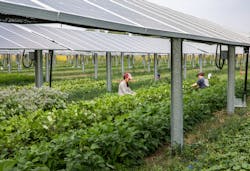Iowa State University Inaugurates $1.8M Agrivoltaics Solar Array Research Project
Iowa State University (ISU) has inaugurated its 1.757 MWDC Alliant Solar Farm, a research project that merges solar power generation and agriculture to understand how to optimize land use while providing benefits to the local community.
Horticulture and agriculture students attending ISU will plant crops, such as vegetables, fruits, and pollinator habitats, and study how they perform under solar arrays with varying heights and configurations. Engineering students will analyze solar production data to determine how various crop plantings impact solar production and how solar site maintenance impacts cultivation.
"As renewable energy grows, it's important to find opportunities for these projects to benefit people beyond just providing renewable electricity,” said Anne Kimber, Director of the Electric Power Research Center. “There's good work to be done on this front, and we hope this research and demonstration will help identify the potential for communities to benefit from agrivoltaics.”
The solar research project was a collaborative effort between ISU and Alliant Energy, which owns and operates the solar array on land leased from the university. Waldinger Corporation was the general contractor, while Ideal Energy was appointed as the subcontractor for solar design, procurement, monitoring, and solar commissioning.
Ideal Energy designed the solar field in two parts:
The first part was an 811 kWDC south-facing fixed-tilt solar array. Ideal Energy installed six fixed-tilt rows with standard leading edges two feet off the ground and three fixed-tilt rows with leading edges five feet off the ground. This will allow the university to test if higher solar arrays create optimal growing conditions.
The second part was a 946 kWDC single-axis active tracker. Eighteen of the rows are the standard five to six feet above the ground, while five rows were heightened to eight to nine feet above the ground. All the solar panels on site are bifacial, allowing them to generate power from both sides.
By adjusting the solar equipment height in each part, the university will be able to test if higher solar arrays provide more optimal growing conditions and solar power generation.
Iowa State University’s research project was the recipient of a four-year $1.8 million grant from the U.S. Department of Energy’s Foundational Agrivoltaic Research for Megwatt Scale (FARMS) project. ISU was one of only six organizations to receive a portion of the program’s $8 million total funding package.
About the Author
Breanna Sandridge, Senior Editor
Breanna Sandridge is senior editor for EnergyTech and Microgrid Knowledge, both part of the energy group at Endeavor Business Media.
Prior to that, Breanna was managing editor for Machinery Lubrication and Reliable Plant magazines, both part of Noria Corp. She has two years experience covering the industrial sector.
She also is a 2021 graduate of Northeastern State University (Oklahoma) with a Bachelor's in English.
